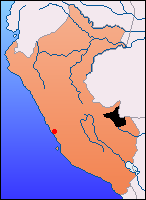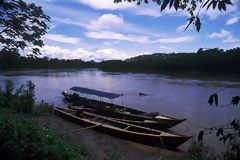 |
Related pages: |
 In the region of Madre de Dios, fascinating archaeological remains have been discovered, including the petroglyphs of the Palotoa-Shinkebenia and Urubamba rivers, located in the Pontiacolla mountain range. These ancient stone carvings, dating back centuries, have attracted the attention of anthropologists and historians due to their cultural significance. These petroglyphs serve as a testament to the early inhabitants of the region, a people who lived in harmony with nature and left their mark through these rock engravings.
In the region of Madre de Dios, fascinating archaeological remains have been discovered, including the petroglyphs of the Palotoa-Shinkebenia and Urubamba rivers, located in the Pontiacolla mountain range. These ancient stone carvings, dating back centuries, have attracted the attention of anthropologists and historians due to their cultural significance. These petroglyphs serve as a testament to the early inhabitants of the region, a people who lived in harmony with nature and left their mark through these rock engravings.
During the reign of Inca Roca, the Incas made contact with the indigenous peoples of the Madre de Dios region. Although these lands remained on the fringes of the Inca Empire, they held some strategic importance due to their natural resources. The Incas, as both conquerors and diplomats, managed to establish relationships with the local populations, who primarily relied on fishing and agriculture for survival. The fish-rich rivers and forests provided the necessary resources for these peoples to thrive.
With the arrival of the Spanish, the region attracted a different kind of interest. One of the first expeditions to venture into these remote lands was led by Juan Alvares Maldonado at the beginning of the Spanish conquest. This expedition marked the start of European exploration in this part of the Amazon jungle, although the Viceroyalty of Peru paid little attention to the region in the following centuries.
It was primarily Dominican missionaries who began to settle in the region, seeking to convert the local populations and establish missions in the most remote corners of the forest. They played a crucial role in the history of the region, although their influence remained limited during colonial times. It wasn’t until the arrival of Colonel Faustino Maldonado that the region experienced its first signs of economic growth.
At the end of the 19th century, the Madre de Dios region saw significant development thanks to the rubber boom. The dense forests were full of rubber trees, a highly sought-after raw material at the time. This trade attracted adventurers, traders, and settlers eager to profit from this new economic opportunity. However, this rapid development had devastating consequences for the local populations, who were often enslaved to exploit the region's natural resources.
The 20th century brought new opportunities with the discovery of gold deposits in the Madre de Dios river basin. This gold rush attracted thousands of miners seeking fortune, transforming the region once again. Today, logging and mining remain key sectors of the local economy, although these activities pose significant environmental challenges. The Amazon rainforest, often referred to as the "lungs of the world," is now threatened by extensive deforestation, raising growing concerns about the future of this unique region.
Madre de Dios is a region where history, nature, and modern economic challenges intersect. From ancient archaeological remains, Inca contact, and economic booms in rubber and gold, the region continues to evolve. However, preserving its fragile ecosystem remains a priority to ensure the future of this region and the people who have lived there for centuries.